

RNAi Therapeutics, My Long View. Warning: disorganized thoughts gathered on a long plane ride.

Having followed the development of RNAi Therapeutics since it took off in 2001, I submit that its trajectory continues to strongly suggests that it will become an important new class of drugs. I am not saying that capital has always been well spent and that the field has been free from scientific and securities 'fraud' (meant in a broader sense). However, from a 30.000 feet level, a dozen years from the demonstration of RNAi activity in mammalian tissue culture cells to demonstrating potent gene knockdown in Man following systemic administration is more than satisfactory progress. With the momentum fairly intact, certainly somewhat dented by a financially trying spell (2009-12), I expect that RNAi Therapeutics will have real clinical impact over the next dozen years.
Not just the science Unfortunately for investors, this optimistic long view for the technology is no assurance of financial success. Investment Principles. The RNAi Therapeutics Investment Guide for 2013 (Report) What is driving the RNAi Therapeutics market, where are the pockets of value creation, and where are the risks?
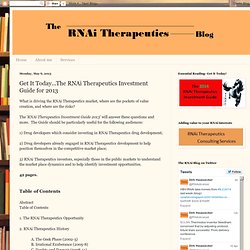
The 'RNAi Therapeutics Investment Guide 2013' will answer these questions and more. The Guide should be particularly useful for the following audiences: 1) Drug developers which consider investing in RNAi Therapeutics drug development; Is Alnylam Foolishly Betting the Farm on GalNAcs? It is remarkable that Alnylam seems to be embracing GalNAc subcutaneous delivery for all pipeline candidates, but for perhaps ALN-TTR02, that are most important to its 5x15 TM development and commercialization strategy: ALN-TTRsc (TTR amyloidosis), ALN-AT3 (hemophilia), and ALN-AS1 (acute intermittent porphyria).

Considering that gene knockdown has not been demonstrated in Man with GalNAc conjugates, and potency could be a critical issue determining whether this really is a subQ approach, this apparent high-risk strategy is uncharacteristic of a company with the laudable attitude of raising capital when the company does not need it. Alnylam and The Medicines Company to Position RNAi PCSK9 Drug Candidate as Fast Follower.
Yesterday, Alnylam made the somewhat surprising announcement that it partnered with the ~$1.6B market cap The Medicines Company to develop and commercialize its RNAi Therapeutic program targeting PCSK9 for hypercholesterolemia.
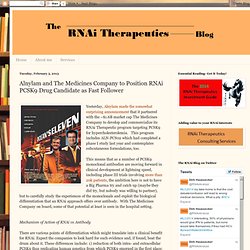
This program includes ALN-PCS02 which had completed a phase I study last year and contemplates subcutaneous formulations, too. This means that as a number of PCSK9 monoclonal antibodies are moving forward in clinical development at lightning speed, including phase III trials involving more than 20k patients, the ambition here is not to have a Big Pharma try and catch up (maybe they did try, but nobody was willing to partner), but to carefully study the experiences of the monoclonals and exploit the biological differentiation that an RNAi approach offers over antibody.
With The Medicines Company on board, some of that potential at least is seen in the hospital setting. With USDA Grant, KSU Doctoral Student Aims to Use RNAi to Fight Plant Virus. Marina Defaults on Loan as Bankruptcy Looms. Researchers Report on Use of RNAi to Combat Bee Parasite. ALN-VSP02 Was a Good Start, but Directs Focus Towards Improved Formulations. Alnylam recently published detailed phase I results from its RNAi Therapeutic candidate to treat liver cancer, ALN-VSP02.

Although results from this study had already been reported, the new paper by Tabernero and colleagues provides an insightful warts-and-all view of Tekmira's SNALP generation 1.0 (short-circulating DLinDMA particles) in a solid cancer. The results show that while ALN-VSP02 did achieve a number of important goals, including evidence of tumor response and RNAi activity, it will be necessary to turn to the newer SNALP formulations for more robust efficacy and improved safety. New Insights on ALN-VSP02 Activity Previously, Alnylam provided clear evidence of RNAi activity using the 5' RACE assay. It is now clear, however, that this was only based on 3 positive biopsies out of 15 investigated in this regard, and only for the VEGF, but not the KSP target gene. First Antisense Oligo Approved for Gene Knockdown in Liver.
In a milestone for antisense oligonucleotide technology, Kynamro (aka mipomersen) yesterday received regulatory approval for the treatment of homozygous familial hypercholesterolemia (hoFH).
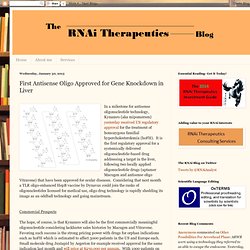
It is the first regulatory approval for a systemically delivered oligonucleotide-based drug addressing a target in the liver, following two locally applied oligonucleotide drugs (aptamer Macugen and antisense oligo Vitravene) that have been approved for ocular diseases. Considering that next month a TLR oligo-enhanced HepB vaccine by Dynavax could join the ranks of oligonucleotides licensed for medical use, oligo drug technology is rapidly shedding its image as an oddball technology and going mainstream. Commercial Prospects The hope, of course, is that Kynamro will also be the first commercially meaningful oligonucleotide considering lackluster sales histories by Macugen and Vitravene. RNAi versus Antisense for gene knockdown in the liver.
India's Department of Biotechnology Issues Call for RNAi Research Proposals. Alnylam, Tekmira Shares Regain Lost Ground Heading into 2013. RNAi pathways contribute to developmental history-dependent phenotypic plasticity in C. elegans. Alnylam to Sell $125M in Stock. Monsanto Moves Four RNAi Products through Pipeline, Posts Improved Fiscal First Quarter Financials. Alnylam Sets Record With $125M Secondary Offering.
The $125M stock offering just announced by Alnylam may well be the largest secondary offering in the history of RNAi Therapeutics.
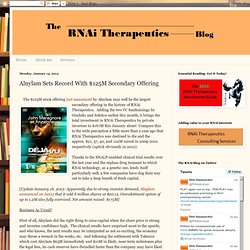
Adding the two VC fundraisings by Gradalis and Solstice earlier this month, it brings the total investment in RNAi Therapeutics by private investors to $167M this January alone! Compare this to the wide perception a little more than a year ago that RNAi Therapeutics was destined to die and the approx. $21, 57, 40, and 122M raised in 2009-2012 respectively (uptick obviously in 2012). Thanks to the SNALP-enabled clinical trial results over the last year and the orphan drug tsunami to which RNAi technology, as a genetic one, lends itself particularly well, a few companies have dug their way out to take a deep breath of fresh capital.
[Update January 16, 2013: Apparently due to strong investor demand, Alnylam announced on Jan15 that it sold 8 million shares at $20.13. Overalottment option of up to 1.2M also fully exercised. In Print: Last Month's RNAi- and microRNA-Related Papers of Note. Bidirectional Transfer of RNAi between Honey Bee and Varroa destructor: Varroa Gene Silencing Reduces Varroa Population. Abstract The mite Varroa destructor is an obligatory ectoparasite of the honey bee (Apis mellifera) and is one of the major threats to apiculture worldwide.
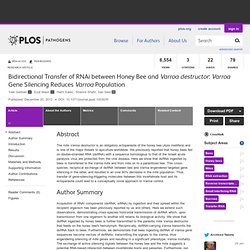
We previously reported that honey bees fed on double-stranded RNA (dsRNA) with a sequence homologous to that of the Israeli acute paralysis virus are protected from the viral disease. Here we show that dsRNA ingested by bees is transferred to the Varroa mite and from mite on to a parasitized bee. This cross-species, reciprocal exchange of dsRNA between bee and Varroa engendered targeted gene silencing in the latter, and resulted in an over 60% decrease in the mite population.
Thus, transfer of gene-silencing-triggering molecules between this invertebrate host and its ectoparasite could lead to a conceptually novel approach to Varroa control. Author Summary Acquisition of RNAi components (dsRNA, siRNA) by ingestion and their spread within the recipient organism has been previously reported by us and others. Figures Editor: David S. OSU Researcher Sanctioned for Falsifying microRNA Data.
New Products: TATTA's microRNA Profiling Service. RNAi Therapeutics. RNAi Therapeutics. RNAi Drug Delivery Startup Solstice Closes $18M Series Financing Round. Alnylam Adds New Program to Pipeline as It Shelves Anemia Candidate. VC investment in RNAi Therapeutics Platform Technology Symbolizes Turning Point. The news this week that a young Southern Californian start-up has raised $18M in VC funding may not seem that much of an event in the greater scheme of things.
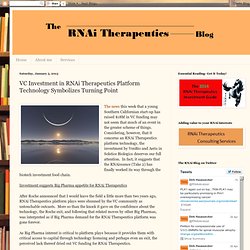
Considering, however, that it concerns an RNAi Therapeutics platform technology, the investment by VenBio and Aeris in Solstice Biologics deserves our full attention. In fact, it suggests that the RNAissance (Take 2) has finally worked its way through the biotech investment food chain. Investment suggests Big Pharma appetite for RNAi Therapeutics After Roche announced that I would leave the field a little more than two years ago, RNAi Therapeutics platform plays were shunned by the VC community as untouchable outcasts. More so than the knock it gave on the confidence about the technology, the Roche exit, and following that related moves by other Big Pharmas, was interpreted as if Big Pharma demand for the RNAi Therapeutics platform was gone forever. UCSD biotech spinoff snags $18M A round to advance RNAi drugs. West Coast biotech vets have joined forces to solve one of the thorniest delivery issues in the industry--ushering RNA drugs into cells.
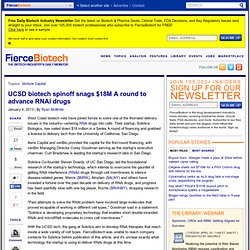
Their startup, Solstice Biologics, has nailed down $18 million in a Series A round of financing and grabbed a license to delivery tech from the University of California, San Diego. Aeris Capital and venBio provided the capital for the first-round financing, with venBio Managing Director Corey Goodman serving as the startup's executive chairman. Gradalis Raises $24M in Series B.
Isis Sued over Stock Drop following Kynamro Safety Report by FDA. People in the News: Michael Khan. Alnylam Files to Begin Phase I Trial of Subcutaneous TTR Drug in UK. What to Expect from RNAi Therapeutics in 2013. 2012 was the most exciting year in the ~12-year history of RNAi Therapeutics- both from a scientific and financial perspective.
Left for dead by most, unambiguous gene knockdown results in Man have allowed the technology to regain much-needed respectability. With the start of 2013, the industry is looking to build on these successes with additional clinical trial results, interesting new therapeutic candidates and product-specific and platform-related deals, particularly in the area of delivery. With appetite for innovation increasing in a low interest rate economy and with the orphan drug tsunami, 2013 could be a quite rewarding year for the discerning investor. Clinical results to look out for For ALN-TTR02, it will be important to confirm the impressive knockdown results from the phase I study, but over longer periods of time and with still acceptable safety.
RNAi Field Looks to Late-Stage Clinical Data, Approvals to Regain Pharma Interest. UNC Researchers Report New Details on Role of miR-122 in HCV. Sirnaomics Presents Preclinical HPV Data. Arrowhead Inks Peptide Delivery Tech Deal with Shire. Arrowhead and Alnylam Vying for Subcutaneous RNAi Delivery Success. The use of the intravenous route of administration for the currently leading systemic RNAi delivery technology, Tekmira’s SNALP technology, has been noted to be a drawback of the technology, especially for non-severe diseases and in therapeutic areas historically dominated by oral medicines (e.g. the cholesterol-lowering market).
As a result, the arrival of two delivery approaches that promise to allow for subcutaneous administration has been welcomed: Arrowhead’s Dynamic Polyconjugates (DPCs) and Alnylam GalNAc-siRNA conjugates which have shown data suggesting their clinical use for gene knockdown in the liver (at least initially; DPC with potential to go beyond the liver). A day ahead of Alnylam’s Roundtable on conjugate delivery, I thought it would be a good time to get into the mood and compare the two competing technologies. Basic Chemistries. Isis, Biogen Idec Ink Antisense Drug-Development Partnership. SNALP Structure Reconsidered. SNALP delivery technology has not only been the subject of a heated fight over ownership and control, but also continued mechanistic, chemistry, and structural investigations.
In terms of structure, I used to think of SNALP as simple, unilamellar liposomes with RNAi triggers captured in their aqueous interiors. A patent application by Tekmira (WO2012/000104A1) and a recent paper by the Cullis/AlCana group (Leung et al., 2012) convincingly challenge this view. Accordingly, SNALP particles are highly electron-dense entities in which pockets of RNAi triggers surrounded by positively charged lipid micelles lipids fill a lipid-enclosed vesicle. This new view should guide the future development of the technology, especially the ratio space of its components, targeted delivery approaches, and cytoplasmic release. Marina Extends Cash Runway to Year End, Sells Off Equipment. NIH Awards Grants to Study miRNAs in Melanoma, Cleft Palate.
RNAi Transfection. Q&A: SBMRI's Mark Mercola on microRNA Screening and Embryogenesis. RXi Begins Second Phase I Trial of Anti-Scarring Drug. UniQure Enters RNAi Field with Benitec Cross-Licensing Deal. Tekmira Licenses UNA Technology from Marina. In Print: Last Month's RNAi- and microRNA-Related Papers of Note. An RNAi screen identifies additional members of the Drosophila Integrator complex and a requirement for cyclin C/Cdk8 in snRNA 3′-end formation. Arrowhead Research, Focus on RNAi Therapeutics. Arrowhead Research just announced the publication of a scientific paper detailing its fundamentally new DPC delivery approach (discussed here before).
Except for noting that this study is a proof-of-concept one only and, based on recent conference presentations, clinically more relevant formulations have been developed, I am feeling more compelled to talk about my thoughts on Arrowhead’s corporate strategy than to give you are run-down of the paper that you can also read yourself here. A Dubious Past When I used to think of Arrowhead, a company came to mind that was constantly chasing the latest hot area in science and technology to raise the next round of money, and never pursuing anything in great detail.
And it is great detail that is required if you really want to make a product, especially a drug. It got worse during the economic downturn when the company claimed to be a broad RNAi platform play and did not even have a lab to show. People in the News: Victor Knopov. New Products: Exiqon's MiRcury RNA Isolation Kit — Biofluids. Tuschl Patents Stage Remarkable Comeback in US. [please note the changes below after I discovered that I missed the last claim amendments, as correctly pointed out by a commenter] Alnylam announced today that the patent office had issued 3 Notices of Allowance in recent weeks pertaining to the Tuschl patent estate. Before your eyes glace over, read on, it's actually one of the few important patent news. The granted composition-of-matter claims cover very broadly 19-25bp RNAi triggers, independent of structure. This is a stark departure from the trend that had materialized in the Tuschl patent applications where Tuschl I seemed to get relegated to treating diseases of fly lysates and Tuschl II suffering from double-patenting issues over Tuschl I.
Claim 1 of allowed patent application 12/537602: 1. 1. The reason why such a comeback was possible can be traced back to the settlement over the Tuschl patents 'with Merck' in early 2011. Tuschl Patents Stage Remarkable Comeback in US. [please note the changes below after I discovered that I missed the last claim amendments, as correctly pointed out by a commenter] Alnylam announced today that the patent office had issued 3 Notices of Allowance in recent weeks pertaining to the Tuschl patent estate. RNAi and Antisense Targeting the Same Gene: Not a Zero-Sum Game. SNALP Works! Demystifying ddRNAi Trigger Design. Alnylam And Tekmira Settle RNAi Dispute. Alnylam Presents Preclinical Data on AAT Deficiency Drug. People in the News: Robert Gish. Alnylam, Tekmira Look Ahead After RNAi Divorce. Luke Timmerman11/14/12. Business, Life Sciences, and Technology News. Tekmira Regains Control over Leading Delivery Technology.
Search - CORDIS - EUROPA. Alnylam Says Estimates of Damages in Tekmira Suit Could Reach $1.5B. New Products: Affymetrix's Axiom. Regulus Grosses a Total of $80.9M from Recent Transactions. DuPont, CSHL Extend Plant Biology Research Alliance. Benitec Closes Tacere Acquisition. Cautionary Statements in Alnylam's SEC Filing. Today, I would like to post excerpts from Alnylam's most recent quarterly filing with the SEC (10-Q, here), comments that are related to the trade secret litigation between Alnylam and Tekmira. Since the use of cautionary language is strongly encouraged for public companies to protect themselves from shareholder lawsuits, such filings are a great way to glean some insights into how they think about legal proceedings.
Although Alnylam claims that a loss, including resulting from a settlement, is 'less than probable', they certainly acknowledge the significant potential liability. For the first time, Alnylam discloses what it considers an appropriate damage estimate- a meager (less than) $4.4M, but which makes me wonder whether the manufacturing accusations have been more or less admitted to (highlights are mine): 'The Company has not recorded an estimate of the possible loss associated with this legal proceeding.
The jury trial is slated to start next week. In Print: Last Month's RNAi- and microRNA-Related Papers of Note. Bullish on RNAi Therapeutics. RNAi Therapeutics. The Mipomersen Briefing Docs: Gymnotic Delivery Revealed. An RNAi screen identifies additional members of the Drosophila Integrator complex and a requirement for cyclin C/Cdk8 in snRNA 3′-end formation. + Author Affiliations Abstract. Genzyme Taps RNAi Therapeutics for TTR Amyloidosis. Large-Scale Field Application of RNAi Technology Reducing Israeli Acute Paralysis Virus Disease in Honey Bees (Apis mellifera, Hymenoptera: Apidae)
Large-Scale Field Application of RNAi Technology Reducing Israeli Acute Paralysis Virus Disease in Honey Bees (Apis mellifera, Hymenoptera: Apidae) Arrowhead Gets OK for Delivery Technology Patent. Benitec Provides Pipeline Update Following Tacere Acquisition. Working to Stay Afloat, Marina Aims to Avoid Becoming Latest RNAi Drug Disappearing Act.